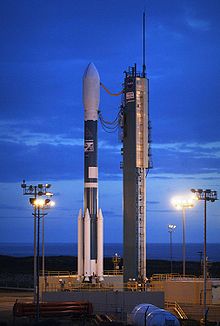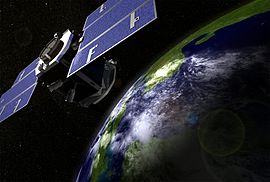- CloudSat
-
CloudSat
Artist's Concept of CloudSatOperator NASA Major contractors Ball Aerospace and Technologies Corp. Mission type Earth orbiter Launch date April 28, 2006 Launch vehicle Delta II Mission duration 22 months primary mission Homepage CloudSat home page Power Solar panels  The Delta II rocket with CloudSat and CALIPSO on Launch Pad SLC-2W, VAFB.
The Delta II rocket with CloudSat and CALIPSO on Launch Pad SLC-2W, VAFB.
CloudSat is a NASA Earth observation satellite, which was launched on a Delta II rocket on 28 April 2006. It uses radar to measure the altitude and properties of clouds, adding to information on the relationship between clouds and climate in order to help resolve questions about global warming. CloudSat flies in formation in the "A Train", with several other satellites (Aqua, Aura, CALIPSO and the French PARASOL).
The mission was selected under NASA's Earth System Science Pathfinder program in 1999. Ball Aerospace & Technologies Corp. in Boulder, Colorado, designed and built the spacecraft.
The main instrument on CloudSat is the Cloud Profiling Radar (CPR), a 94-GHz nadir-looking radar that measures the power backscattered by clouds as a function of distance from the radar. The radar instrument was developed at NASA's Jet Propulsion Laboratory(JPL) in Pasadena, California, with hardware contributions from the Canadian Space Agency. The overall design of the CPR is simple, well understood, and has a strong heritage from the many cloud radars already in operation in ground-based and airborne applications. Most of the design parameters and subsystem configurations are nearly identical to those for the Airborne Cloud Radar, which has been flying on the NASA DC-8 aircraft since 1998.
The CPR capitalizes on existing radar expertise and experience at JPL. Other radars already flown successfully or being developed by JPL include the Seasat SAR, SIR-A, SIR-B, SIR-C, the Shuttle Radar Topography Mission, Cassini Radar, NSCAT, QuickScat, and SeaWinds.
CloudSat's primary mission was scheduled to continue for 22 months in order to allow more than one seasonal cycle to be observed. Based on radar lifetime data, NASA expects the radar to operate for three years with a 99 % probability.
CloudSat is managed by the Jet Propulsion Laboratory. Colorado State University provides scientific leadership and science data processing and distribution. The cost of this project is approximately 200 million dollars.[1]
See also
- A-train (satellite)
- Earth Observing System
- List of spaceflights (2006)
rocket launches
References
External links
- Cloudsat home
- Cloudsat data center
- CloudSat and the A Train
- CloudSat Mission Profile by NASA's Solar System Exploration
- Spacecraft seek climate clarity
Meteorological remote sensing systems in Earth orbit Concepts Current projects A-train satellitesOther satellitesCBERS · COSMIC (FORMOSAT-3) · COSMO-SkyMed · DMSP · DMC · Elektro-L · Envisat · EROS · ERS · Fengyun · FORMOSAT-2 · GOES · IKONOS · Landsat · MetOp · Meteor · Meteosat · MTSAT · NOAA-N' · QuickBird · RADARSAT-1 · RADARSAT-2 · SMOS · SPOT · TerraSAR-X · THEOSFormer projects CompletedFailedCategories:- Earth observation satellites
- Artificial satellites orbiting Earth
- Spacecraft launched by Delta II rockets
- United States spacecraft stubs
Wikimedia Foundation. 2010.

